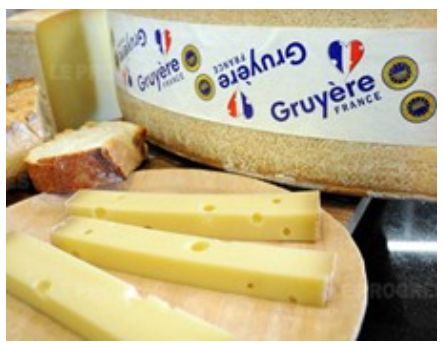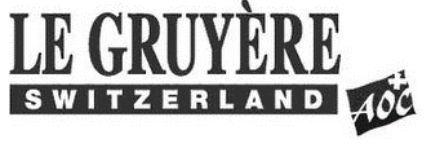The Fourth Circuit waded into the tricky area of geographical indications and emerged with some delightfully cheesy puns. Asked to decide whether the term "gruyere" signifies merely a particular type of cheese, or specifically cheeses produced in the Le Gruyère region of Switzerland and France, the Court concluded that "gruyere" is a generic term for a kind of cheese, and thus not registrable as a certification mark.

European Union regulations govern the use of certain registered designations for agricultural products, such as cheese, wine, olive oil, etc. These designations fall under one of several regulatory schemes, including "protected designation of origin" (PDO) and "protected geographical indication" (PGI). PDOs and PGIs establish criteria that agricultural products must meet to use the protected designation, typically including origination in a specified geographic area (to ensure that the foodstuffs possess the qualities that result from being grown or produced in a certain climate, soil environment, etc.), and production using specified methods (often aimed at preserving traditional know-how). The EU PDO/PGI system prevents use of protected terms by unauthorized entities within the EU and certain other jurisdictions. It is not, however, enforceable in the United States.
The United States does not have a legal system for protecting designations of origin as such. Instead, the use of specific terms to identify food items may be governed by regulations promulgated by the certain federal agencies, including the Food and Drug Administration (FDA), and potentially by trademark law. With respect to trademark protection, organizations seeking to control which producers may be permitted use certain terms to identify food items can attempt to register the relevant terms as certification marks. Certification marks are not used by the owner of the mark but rather by third parties whose goods or services the mark owner has certified as meeting certain established criteria. Like any mark, however, a certification mark must be distinctive. In other words, a term cannot serve as a certification mark if its significance to consumers is to indicate the generic type of goods or services, rather than that the source of those goods or services has been certified by an authoritative entity.
In the case of gruyere cheese, the FDA has established a "standard of identity." Under this standard, to be labeled legally as "gruyere" in the United States, cheese must be "prepared by the procedure set forth in [the regulation] or by any other procedure which produces a finished cheese having the same physical and chemical properties." 21 C.F.R. 133.149. The FDA standard of identity notes that gruyere "has a mild flavor, due in part to the growth of surface-curing agents" and that "[t]he cheese is at least 90 days old." Id. The regulation also describes in detail what ingredients may be used, and the process to be followed, to produce the cheese. Id. Notably, however, the FDA's standard of identity for gruyere contains no regulations regarding the geographic source of the ingredients or the location of production.
In an effort to impose geographic restrictions on which cheese producers can use the term "gruyere" in the United States, the two European organizations responsible for controlling that term in the EU - the Swiss Interprofession du Gruyère (a PDO) and the French Syndicat Interprofessionel du Gruyère (a PGI) (together, the "Consortiums") - jointly applied to register GRUYERE as a certification mark with the USPTO. The USPTO published the application for opposition, and various cheese producing parties, including the U.S. Dairy Export Council ("Opposers") opposed it. The TTAB sided with the Opposers and refused registration, finding that the term "gruyere" is generic because "purchasers and consumers of cheese understand the term 'gruyere' as a designation that primarily refers to a category within the genus of cheese that can come from anywhere." International Dairy Foods Ass'n v. Interprofession du Gruyère and Syndicat Interprofessional du Gruyère, Opp. No. 91232472, at 65 (TTAB 2020).
The Consortiums challenged the TTAB's decision by filing a complaint in the United States District Court for the Eastern District of Virginia, which granted summary judgment in favor of the Opposers. The Consortiums then appealed to the Fourth Circuit. In March 2023, the appeals court affirmed TTAB/district court decisions, agreeing with both lower tribunals that "gruyere" is unregistrable because it is generic.
On appeal, the Consortiums challenged three categories of evidence on which the district court had relied. The Fourth Circuit agreed that the district court had made certain erroneous factual inferences but ultimately found that, even without those inferences, each category of evidence supported a finding that "gruyere" is generic.
First, the Court found that the FDA standard of identity for "gruyere" provided strong evidence that the term was generic. Because the FDA standard has been governing use of the term "gruyere" in the United States for more than 40 years, the Court reasoned that it has influenced what consumers see as "gruyere" cheese. And as the standard does not impose any geographic restrictions on use of the label "gruyere," it follows that consumers likewise do not expect the term "gruyere" to indicate a particular geographic origin. The Consortiums argued that the Court should not accord weight to the FDA standard because other cheese names (such as REGGIANO and ROQUEFORT) are subject to both an FDA standard of identity and a certification mark, and because the U.S. Supreme Court held in Pom Wonderful LLC v. Coca-Cola Co., 573 U.S. 102 (2014), that compliance with FDA labeling regulations did not shield food producers from liability under the Lanham Act. The Court rejected these arguments, however, noting that it merely found the FDA standard to be probative of genericness; it did not necessarily preclude protection of GRUYERE as a certification mark.
Second, while the Court agreed with the Consortiums that the district court made certain improper inferences about sales volume figures, it found that the undisputed evidence nevertheless indicated that a substantial volume of cheese sold as "gruyere" in the United States originated outside of Switzerland and France. The Court considered this evidence probative of genericness because it suggested that consumers are accustomed to seeing the term "gruyere" applied to non-Swiss and non-French cheese, and are therefore less likely to understand that term as signifying a particular geographic origin.
Finally, the Court looked at evidence of common usage of the term "gruyere." The Court agreed with the Consortiums that it had been error for the district court to conclude that dictionary definitions supported a finding of genericness, when several dictionary definitions in evidence did in fact specify that "gruyere" cheese comes from the Le Gruyère region. However, the Court found that numerous online references to "gruyere" did not specify any geographic origin and, more importantly, some specified a geographic origin other than Switzerland or France. This evidence provided further support for the conclusion that U.S. consumers understand "gruyere" to refer merely to a type of cheese.
The Court also rejected the Consortiums' arguments that summary judgment of genericness was improper in the absence of consumer survey evidence or with respect to a term that was not commonly used prior to its association with the products at issue (in other words, a term that began as distinctive and became generic over time).
Having found the Consortiums' arguments unavailing, the Court upheld the district court's summary judgment ruling and the refusal to register GRUYERE as a certification mark. It is worth noting, however, that the Swiss consortium does own an earlier registration for the following design as a certification mark (with disclaimer of exclusive rights in "Switzerland" and "AOC" but not in "Gruyère"):

Thus, if you are searching for gruyere cheese that actually originates in the Le Gruyère region (of Switzerland, at least), this mark should help you sniff out a geographically certified product. If, however, you are like most consumers in the Fourth Circuit's view - you just want that nutty flavor, and you don't care where your gruyere originates - then the world is your cheese platter.
The case is Interprofessionel du Gruyere v. U.S. Dairy Export Council, 61 F.4th 407 (4th Cir. 2023).
The content of this article is intended to provide a general guide to the subject matter. Specialist advice should be sought about your specific circumstances.


